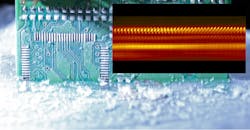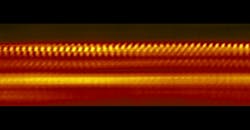Atomically thin materials developed by Stanford University researchers could create heat-shields for cell phones or laptops that would protect people and temperature-sensitive components, in addition to making future electronic gadgets even more compact.
Excess heat given off by smartphones, laptops, and other electronic devices can be annoying, but it can also cause malfunctions and, in extreme cases, can even cause lithium batteries to explode. To guard against such problems, engineers often use thin sheets of glass, plastic, or even layers of air as insulation.
Now, Stanford researchers have shown that a few layers of atomically thin materials, stacked like sheets of paper atop hot spots, can provide the same insulation as a sheet of glass 100 times thicker. “In the near term, thinner heat shields will let engineers make electronic devices even more compact than those we have today,” says Eric Pop, a Stanford professor of electrical engineering.
The heat from smartphones or laptops is actually an inaudible form of high-frequency sound.
Consider the underlying physics: Electricity flows through wires as a stream of electrons. As electrons move, they collide with the atoms of the conductor. With each collision, an electron causes an atom to vibrate. The more current flows, the more collisions occur. Finally, electrons are hitting atoms, and these vibrations move through the conductor at frequencies far above the threshold of hearing—generating energy we feel as heat.
This greatly magnified image shows four layers of atomically thin materials that form a heat-shield just two to three nanometers thick, or roughly 1/50,000th the thickness of a sheet of paper. (Courtesy: NIST)
Thinking about heat as a form of sound inspired Stanford researchers to borrow some principles from the physical world. From his days as a radio DJ at Stanford’s KZSU 90.1 FM, Pop knew music recording studios are quiet, thanks to thick glass windows that block exterior sounds. A similar principle applies to heat shields in electronics. If better insulation were the only concern, the researchers could borrow the music-studio principle and thicken the heat barriers. But that would stymie efforts to make electronics thinner. Their solution was to borrow a trick from windowmakers who install multi-paned windows—usually, layers of air sandwiched between sheets of glass with varying thickness—to make interiors warmer and quieter.
The Stanford team adapted that idea by creating an insulator made of several layers of atomically thin material. Atomically thin materials are a relatively recent discovery. It was only 15 years ago that engineers learned to isolate some materials into such thin layers. The first example was graphene, which is a single layer of carbon atoms. The team used a layer of graphene and three other sheet-like materials, each three atoms thick, to create a four-layered insulator just 10 atoms deep. Despite its thinness, the insulator is effective because heat vibrations are dampened and lose much of their energy as they pass through each layer.
To make nanoscale heat shields practical, the researchers still need to devise a way to mass produce the laminated heat shield. Two possibilities include spraying the shield onto or depositing thin layers of materials onto electronic components during manufacturing.
But behind the immediate goal of developing thinner insulators looms a larger ambition: Scientists hope to one day control the vibrational energy inside materials the way they now control electricity and light. As they come to understand the heat in solid objects as a form of sound, a new field of phononics is emerging.
“As engineers, we know quite a lot about how to control electricity, and we’re getting better with light, but we’re just starting to understand how to manipulate the high-frequency sound that manifests itself as heat at the atomic scale,” Pop says.
Tom Abate is associate director of communications for the school of engineering at Stanford University.


